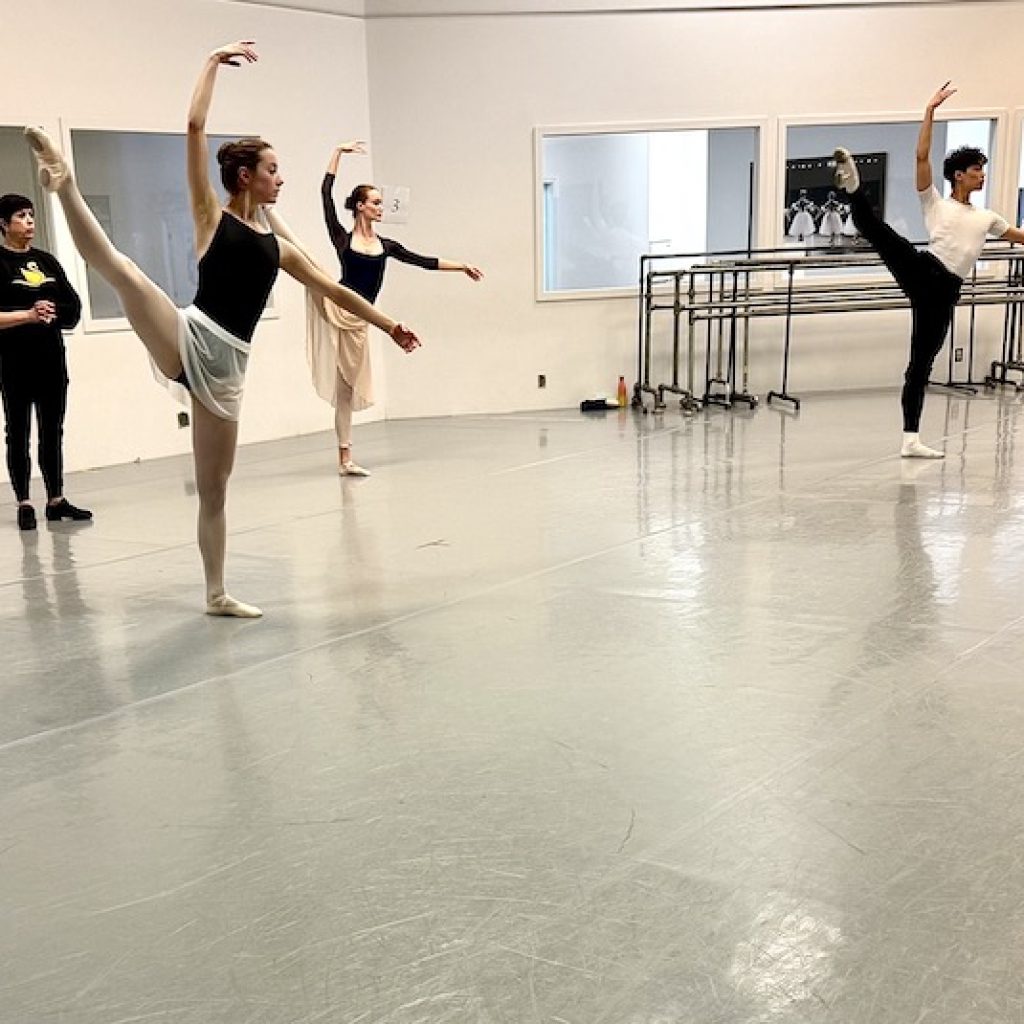Share

Tweet
Share
Share
Many starry-eyed students aspire to a professional ballet career with the dream of being paid to do what they love. Great sacrifices are made to achieve these goals: hours upon hours spent training, missing social activities, withstanding sore muscles, sprained ankles and lots of blisters. All of the blood, sweat and tears are worth it when one is rewarded with a full-time company contract. It doesn’t happen by magic; it takes ambition, careful planning, and savvy navigation through the ins and outs of the bureaucracy of a ballet company.
Intensive training programs
Tyleigh Baugham of BalletMet. Photo by Jennifer Zmuda.
Most aspiring students study in intensive training programs throughout their schooling. Large, well-established institutions typically offer comprehensive pre-professional programs (as well as recreational, less intensive tracks). By the time a serious young dancer starts high school, they have usually been vetted by noteworthy programs and invited to study in their professional divisions. These divisions can be quite intense in the level of training, with classes six days a week, in addition to rehearsals and performances. There are tuition fees and, for a lucky few, scholarships.
Trainees
The next step is usually a trainee position with a company, sometimes referred to as a second company. Trainees are often recent graduates from ballet schools or conservatories. They take advanced classes as well as rehearse with a company, filling in corps positions for ballets like The Nutcracker and Swan Lake. Often the positions are unpaid or offer a small stipend with a modest shoe budget. Some institutions charge tuition. The ultimate goal is for the dancer to gain experience and exposure, with the possibility of being promoted to apprentice level.
Melissa Bowman is the artistic and academy director of Montana Ballet Company. She has previously served as assistant principal of the ABT Jacqueline Kennedy Onassis School and academy director of the Houston Ballet Academy. She has taught dancers of all ages and guided many talented individuals to companies all over the U.S. Her own path to professional dance came at age 15, with a personal invitation by Mikhail Baryshnikov to audition for American Ballet Theatre. That is a more meteoric path to a company, and she advises her own students to pursue a traineeship first. She believes it helps them enter the workforce with greater confidence.
 Tyleigh Baugham of BalletMet. Photo by Jennifer Zmuda.
Tyleigh Baugham of BalletMet. Photo by Jennifer Zmuda.
“The traineeships give both the dancers and directors a chance to work together, build a relationship and see if they work well together,” Bowman explains. “The trainees should anticipate higher expectations from directors as they progress. The traineeship is designed to prepare you for these expectations, ensuring you are as ready as possible for the challenges ahead.”
Tyleigh Baughman is a former dancer with Tulsa Ballet and currently a company artist with BalletMet. For her, being in Tulsa Ballet II was time-consuming and like a full-time job. She shares, “I think it would have been very difficult to continue school while being a part of that program. I had intentionally sped up my schooling by switching to online courses in high school and doing classes every summer. I did this to be able to graduate before joining the program.”
Apprentice
At this level, the students are making the final transition to professional. Apprentices rehearse and perform with the main company, filling in corps de ballet parts. They are treated as company members but may still take some classes with trainees or students. The apprentices are usually paid a small salary, and shoes are provided. The aim is for the dancers to prove themselves to the directors so they can obtain full company contracts.
Baughman was offered an apprentice contract with Tulsa Ballet after spending two years with Tulsa Ballet II. For her, the transition was a challenging experience. She shares, “With how competitive the ballet world is, especially for women, it’s already hard enough getting to a professional status. I do think my transition was quite smooth considering. I had a lot of great instructors growing up who really prepared me, even before my second company days. We had company rep as a class and got to work with some amazing choreographers in the same fast-paced setting that professionals do. I think this was what prepared me most, and without that, I think it would have been a lot more shocking.”
 Melissa Bowman teaching at Montana Ballet Company. Photo courtesy of Karen Smith.
Melissa Bowman teaching at Montana Ballet Company. Photo courtesy of Karen Smith.
She does have some mixed feelings about second companies and apprenticeships. “If they are truly used as a tool then yes, I am all for it! I am lucky enough to say my experience did, in fact, help me with my future endeavors, but I personally do not think that is always the case everywhere. I think it’s easy to smack a label on dancers who maybe are doing just as much if not more work (basically working as a full-time company member); yet since they have this label they are being paid less if anything at all.” She feels this takes advantage of young dancers. “The same goes for things like trainee programs. Do I think they can be very beneficial? Yes! I don’t think it’s ever a ‘waste of time’ if you are putting work into yourself as a dancer, but… I definitely recommend doing your research on what these programs entail, and if it’s worth it for you!”
Bowman adds thoughtfully, “From my experience, the companies are bound by how many contracts they have for any given season. They may love a dancer, but if they don’t have an open contract, they cannot hire them. Rejections like this are not personal. Until any company gives you a contract, I would continue looking for other opportunities.”
What other kinds of skills do dancers need?
Dancers need to have life skills. Bowman recommends working on soft skills and learning how to handle oneself in a company. “Outside of technique, dancers should know how to comport themselves in a professional environment, how to read a schedule, etc.” She adds that dancers often face various psychological challenges, thus making a strong support system essential. She mentioned issues such as performance anxiety, body image concerns and stress as just a few of the obstacles they may encounter. She suggests accessing resources like counselors, therapists and nutritionists, as they can provide dancers with valuable tools to effectively manage these challenges.
 Tyleigh Baugham of BalletMet. Photo by Jennifer Zmuda.
Tyleigh Baugham of BalletMet. Photo by Jennifer Zmuda.
Final tips
Bowman recommends that dancers know what they are looking for in a company and trainee program. “Do your research and see what inspires you. Be tenacious and learn as much as you can while you are a trainee and apprentice. Be open to new ideas.”
Baughman has some thoughtful advice for ambitious young dancers: “Go for it! Audition everywhere you are able to, and make sure you do your research. Remember that it is a stepping stone to get you to your goal!”
By Mary Carpenter of Dance Informa.

ABT, ABT Jacqueline Kennedy Onassis School, advice for dancers, American Ballet Theatre, apprentice, apprentices, aspiring professional dancers, ballet education, BalletMet, dance education, Houston Ballet Academy, intensive training programs, Melissa Bowman, Mikhail Baryshnikov, Montana Ballet Company, pre-professional, pre-professional dancers, professional dancers, second companies, Tips & Advice, trainees, training program, training programs, Tulsa Ballet, Tulsa Ballet II, Tyleigh Baughman





GIPHY App Key not set. Please check settings